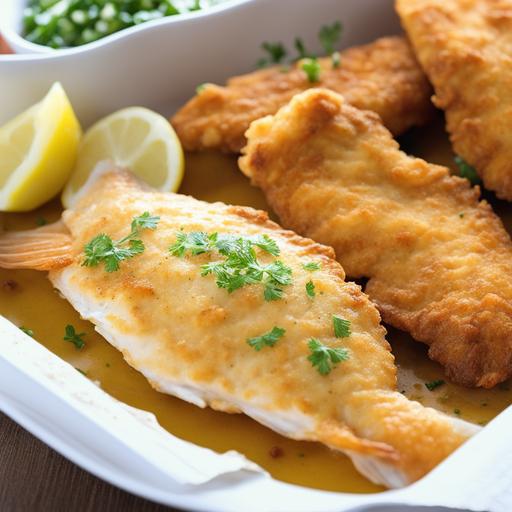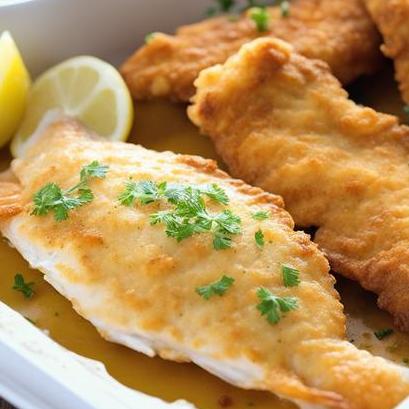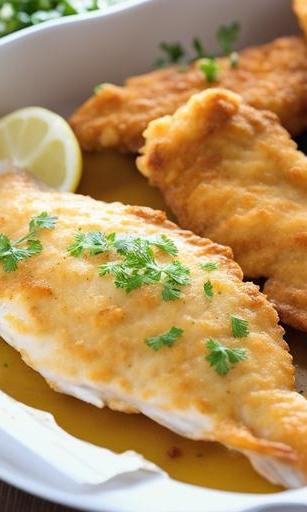[GUIDE] How Long To Cook Battered Fish In Oven

Cooking battered fish in the oven is a fantastic way to achieve a crispy, golden-brown exterior while keeping the fish moist and flavorful on the inside. With a little knowledge and some easy-to-follow instructions, you can perfect this classic dish right in your own kitchen. In this article, we will delve into the important aspects of cooking battered fish in the oven, including cooking time, temperature, techniques, troubleshooting, and more.
Quick Answer: How Long To Cook Battered Fish In The Oven
If you’re looking for a quick answer on the cooking time for battered fish in the oven, it generally takes around 15-20 minutes at 425°F (220°C) or until the fish reaches an internal temperature of 145°F (63°C). However, it’s crucial to note that cooking time can vary depending on factors such as the thickness of the fish fillets and the type of batter being used. It’s always best to use a reliable instant-read thermometer to ensure the fish is cooked to perfection.
Key Takeaways
- Cooking battered fish in the oven provides a crisp and golden exterior while keeping the inside moist and flavorful.
- The cooking time for battered fish in the oven typically ranges from 15-20 minutes at 425°F (220°C) or until the fish reaches an internal temperature of 145°F (63°C).
- Factors that can affect cooking time include the thickness of the fish fillets and the type of batter used.
- Using an instant-read thermometer is the best way to ensure the fish is cooked to the desired temperature.
The Science Of Cooking Battered Fish

Cooking battered fish involves a delicate balance between achieving a crispy exterior and maintaining moisture inside the fish. The batter, when properly cooked, creates a protective layer that helps retain the moisture while providing a satisfying crunch. The oven’s dry heat helps evaporate excess moisture from the batter, giving it a crispy texture.
The Maillard reaction is responsible for the beautiful golden-brown color and appealing flavors that develop during cooking. It occurs when the proteins and sugars in the batter are exposed to high heat, resulting in the delicious caramelization and complex taste.
Choosing Battered Fish
When it comes to choosing battered fish for oven cooking, opt for firm white fish fillets that are less likely to break apart during the cooking process. Good choices include cod, haddock, pollock, or tilapia. These fish varieties are readily available and have a mild flavor that pairs well with the crispy batter.
Ensure that the fish is fresh, odorless, and has firm flesh. Fillets should be even in thickness to ensure even cooking. If the fillets are too thin, they may become overcooked and dry, while thicker fillets may require additional cooking time.
Preparing Battered Fish
Before you begin cooking, there are a few crucial steps to prepare battered fish for the oven:
-
Thaw the fish if it was frozen and pat it dry with paper towels. Excess moisture can prevent the batter from adhering properly.
-
Season the fish with salt and pepper, or any desired spices, to enhance the flavors. This step can be customized based on personal preferences or the type of cuisine you wish to create.
-
Prepare the batter according to your preferred recipe. Whether you choose a traditional beer batter, a tempura-style batter, or a gluten-free alternative, ensure it has a smooth and lump-free consistency.
-
Dip each fish fillet into the batter, ensuring it is fully coated. Allow any excess batter to drip off before transferring the fillets onto a baking sheet lined with parchment paper or a lightly greased baking dish.
Ideal Cooking Temperature For Battered Fish
Selecting the right cooking temperature is essential to achieve the perfect balance between a crispy exterior and tender, moist fish inside. For battered fish, a moderate to high temperature is recommended to allow the batter to crisp up while cooking the fish thoroughly.
A temperature of 425°F (220°C) is a good starting point for cooking battered fish in the oven. This temperature allows for proper browning and ensures that the fish cooks evenly. However, it’s important to note that ovens may vary, so use an oven thermometer to accurately determine the temperature.
Battered Fish Cooking Time

The cooking time for battered fish in the oven can range from 15 to 20 minutes. However, it is crucial to keep in mind that cooking time may vary depending on various factors, including the thickness of the fish fillets and the type of batter used.
To determine the exact cooking time, use an instant-read thermometer to check the internal temperature of the fish. The FDA recommends cooking fish until it reaches an internal temperature of 145°F (63°C). This ensures that the fish is fully cooked and safe to eat while remaining tender and juicy.
Cooking Techniques
There are a few cooking techniques that can help you achieve the perfect result when cooking battered fish in the oven. Here are some pro tips:
-
Preheating the oven: Always preheat the oven before placing the battered fish inside. This ensures consistent heat distribution and helps the batter crisp up quickly.
-
Elevating the fish on a rack: Placing a wire rack on top of the baking sheet allows air to circulate underneath the fish, promoting even cooking and preventing the bottom from becoming soggy.
-
Basting with oil or melted butter: For an even crispier crust, brush the top of the battered fish with a little oil or melted butter before placing it in the oven. This extra layer of fat helps enhance browning and flavor.
-
Flipping halfway through: To ensure even browning, gently flip the battered fish fillets over halfway through the cooking process. This allows both sides to crisp up evenly.
Monitoring And Troubleshooting
While cooking battered fish in the oven, it’s essential to monitor the process to ensure a perfectly cooked result. Here are some troubleshooting tips:
-
Batter sticking to the baking sheet: If you find that the batter is sticking to the baking sheet, lightly grease it with oil or cooking spray before placing the fish fillets. Alternatively, using parchment paper can also prevent sticking.
-
Fish drying out: Overcooking can lead to dry and tough fish. To avoid this, start checking the internal temperature after the initial cooking time. Remove the fish from the oven as soon as it reaches 145°F (63°C) to maintain its moisture.
-
Uneven browning: If you notice uneven browning on the battered fish, rotate the baking sheet halfway through the cooking process. This helps ensure that both sides of the fish receive equal heat exposure.
-
Crispy but undercooked: If the batter appears crispy but the fish is still undercooked, reduce the heat and cook for a few more minutes until the fish reaches the desired internal temperature, without burning the batter.
Remember, practice makes perfect, and don’t be discouraged if your first attempt isn’t flawless. A great meal often comes from learning and adapting along the way.
Battered Fish Cooking Instructions
Now that you have a good understanding of the key aspects of cooking battered fish, here is a step-by-step guideline on how to cook it in the oven:
-
Preheat the oven to 425°F (220°C).
-
Thaw the fish if it was frozen and pat it dry with paper towels.
-
Season the fish with salt, pepper, or any desired spices.
-
Prepare the batter according to your preferred recipe, ensuring a smooth consistency.
-
Dip each fish fillet into the batter, allowing excess batter to drip off.
-
Place the battered fish fillets on a wire rack set on a baking sheet or a lightly greased baking dish.
-
Brush the top of the fish with a little oil or melted butter for extra crispiness (optional).
-
Place the baking sheet in the preheated oven.
-
Cook the fish for approximately 15-20 minutes or until it reaches an internal temperature of 145°F (63°C), flipping the fish halfway through.
-
Remove the fish from the oven and let it rest for a few minutes before serving.
Variations

Once you have mastered the basic method of cooking battered fish in the oven, you can experiment with various flavors and cuisines. Here are a few delicious variations to consider:
-
Seasoned flour: Instead of using a traditional batter, coat the fish fillets in seasoned flour before baking. This method creates a lighter texture while still providing a crispy coating.
-
Panko crust: Replace the traditional batter with a panko breadcrumb crust. Dip the fish fillets in beaten egg and then coat them with panko breadcrumbs for a satisfying crunch.
-
Spicy coating: Add some heat to your battered fish by incorporating spices such as paprika, cayenne pepper, or chili powder into the batter or the flour coating.
-
Herb-infused batter: Enhance the flavor profile by mixing fresh herbs, such as parsley, thyme, or dill, into the batter. This adds a refreshing and aromatic twist to the dish.
Get creative and tailor the flavors to your liking. The possibilities are endless!
When Things Go Wrong
Even with the best intentions and careful planning, things can sometimes go wrong in the kitchen. Here are some common issues that might occur while cooking battered fish in the oven and how to overcome them:
-
Batter sliding off the fish: If the batter slides off the fish during the cooking process, the most likely cause is excess moisture. Ensure that the fish is thoroughly dry before dipping it into the batter. Patting it dry with paper towels can greatly help.
-
Soggy batter: If the batter becomes soggy during cooking, it may be due to overcrowding on the baking sheet. Leaving sufficient space between the fish fillets allows air to circulate and prevents moisture buildup. Consider cooking in batches if needed.
-
Batter not crispy enough: If the batter is not as crispy as desired, you may need to adjust the cooking time or temperature. Increase the cooking time slightly or finish off with a few minutes under the broiler to achieve extra crunchiness.
Remember, cooking is an opportunity to learn and improve. Don’t be discouraged by occasional mishaps, as they often contribute to your culinary know-how.
Serving Battered Fish
Once your battered fish is cooked to perfection, it’s time to serve it up! Here are some suggestions for serving:
-
Serve the battered fish with classic sides such as tartar sauce, lemon wedges, and coleslaw. These accompaniments complement the flavors and textures of the fish.
-
Create a fish and chips experience by serving the battered fish with homemade fries or potato wedges. This combination is a crowd-pleasing favorite.
-
For a lighter option, pair the crispy fish with a fresh green salad or steamed vegetables.
Ultimately, the choice of sides and sauces to serve with your battered fish is entirely up to your taste preferences.
Best Practices For Battered Fish Cooking
To ensure the best results when cooking battered fish in the oven, here are a few additional best practices to keep in mind:
-
Use a reliable recipe: Follow a tried-and-tested recipe that provides clear instructions and ratios for the batter. This helps ensure that the coating adheres well to the fish and doesn’t become greasy or heavy.
-
Practice proper timing: Keep an eye on the cooking time and internal temperature of the fish. Use an instant-read thermometer for accuracy. Overcooking can result in a dry and unappetizing fish.
-
Master your oven: Familiarize yourself with your oven’s specific temperature accuracy and cooking times. Ovens can vary, so understanding the quirks of your appliance will help you achieve consistent results.
-
Have all ingredients and tools ready: Before beginning the cooking process, make sure you have all the necessary ingredients and equipment at hand. This includes the fish, batter, seasonings, baking sheet, thermometer, and any additional spices or sauces you may require.
Conclusion
Cooking battered fish in the oven is a fantastic way to enjoy a crispy, flavorful dish without the mess of deep frying. With the proper cooking time, temperature, and technique, you can achieve an irresistible golden-brown exterior while maintaining a moist and tender interior. Remember to choose the right fish, prepare it properly, and monitor the cooking process carefully to ensure a delicious and satisfying meal. Embrace the possibilities of variations, troubleshoot any issues, and have fun perfecting your own recipe for oven-baked battered fish. Happy cooking!
FAQS
What Kind Of Oven Should I Use To Cook Battered Fish?
You can use any type of oven to cook battered fish as long as it provides an even heat distribution throughout the cooking process..
Can I Cook Battered Fish In An Air Fryer?
Yes, you can cook battered fish in an air fryer as it helps to eliminate excess fat while creating a crispy outer layer of the fish.
In What Temperature Should I Set My Oven When Cooking Battered Fish?
The oven temperature varies depending on the type and thickness of the fish, but generally, for battered fish, preheat your oven to 425°F (218°C).
How Long Should I Cook Battered Fish In The Oven?
For best results, cook the battered fish in the preheated oven for 15 to 20 minutes, or until the fish is golden brown, and the internal temperature is 145°F (63°C).
Can I Use Frozen Battered Fish In The Oven?
Yes, you can use frozen battered fish to cook in the oven. However, you’ll need to adjust the cooking time to ensure the fish is cooked thoroughly and evenly. It’ll usually take between 25 to 30 minutes to cook.
Sources
About the Author Jenny
I'm Jenny, a housewife with an unwavering passion for food. My culinary journey began with my grandmother's kitchen, and it's now a full-fledged food blog. I've turned my love for cooking into a creative outlet, sharing recipes and stories with a global community of fellow food enthusiasts. It's proof that being a housewife can also mean pursuing your passions and savoring life's delectable moments.
